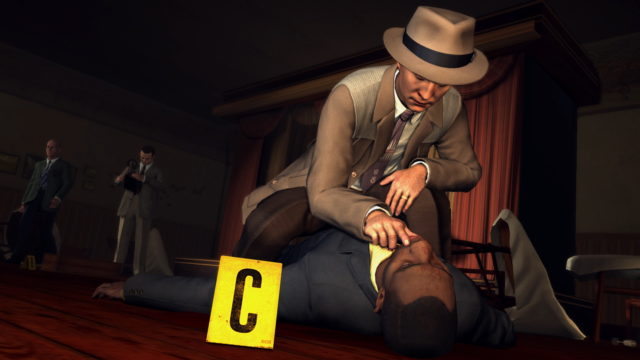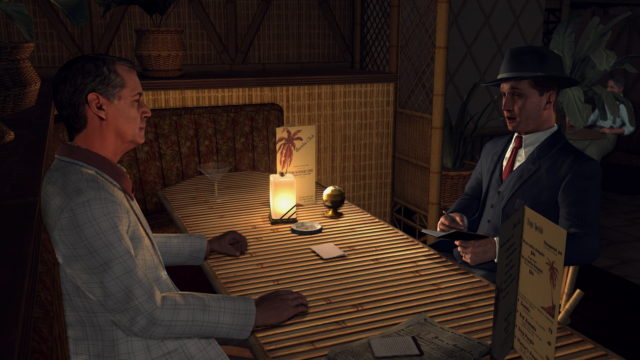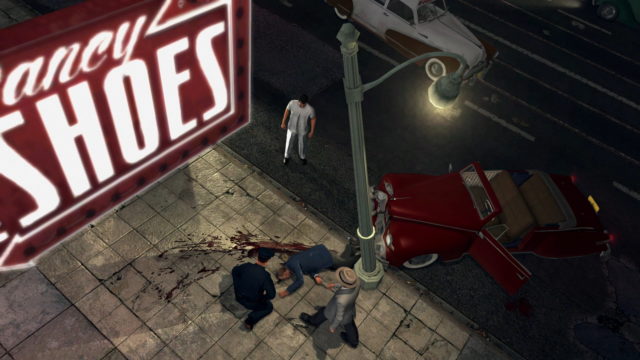Stunning presentation; faithful recreation of 1940s Los Angeles, from the clothing down to the buildings; detective work is done well; Switch features are smartly incorporated and fun to use; incredible voice acting and facial animations.
Some slowdown and occasional graphical hiccups; city has a lot of people, cars, and buildings, but it all tends to feel too much like window dressing; more things to do beyond completing mission objectives would flesh the experience out even further.
L.A. Noire first hit consoles back in 2011 when it launched on Xbox 360 and PlayStation 3. Before it released, there was a misconception among some fans that the game was going to be Grand Theft Auto plopped into 1940s Los Angeles. While L.A. Noire is indeed a Rockstar Games product that also shares the open-world, sandbox gameplay of the Grand Theft Auto series, it is a vastly different experience.
L.A. Noire remains something of an anomaly in the video game industry, eschewing mindless gunplay and skyrocketing body counts in favor of a more cerebral, nuanced experience. Players are cast in the role of Cole Phelps, a former military man returned home and now working as a patrolman for the Los Angeles Police Department. The game’s opening missions quickly transition Phelps into the role of a detective while also imparting the basic skills needed to navigate through cases.
It’s that last bit that makes L.A. Noire so special. Guiding Phelps through the multitude of different mysteries and crime scenes that comprise the game’s narrative remains one of the most unique tasks I’ve ever encountered in a video game. Phelps digs for clues throughout the enormous recreation of Los Angeles that Team Bondi (the original developer of the game) breathed life into. It’s reminiscent of combing environments in the Ace Attorney series, though vastly more realistic and interactive.
Thanks to the innovations Rockstar incorporated into this Switch version of L.A. Noire, there are a number of touch and motion controls that make searching crime scenes and homes more intuitive than ever. I generally am not big on motion controls when I have the option to instead utilize traditional button inputs but, in the case of L.A. Noire on Switch, they’re so soundly implemented that I found myself using them quite a bit. It’s a delightful way of amplifying the sense of immersion that L.A. Noire is so adept at creating.

This is thanks in great part to Team Bondi’s impeccable recreation of 1940s Los Angeles. The authentic rendition of L.A. is a marvel to behold. I can vividly remember how the first time I played L.A. Noire I showed it to my dad and he was able to give me accurate directions as I drove around town that lead me to a variety of famous landmarks. This stunning level of detail extends to the period-accurate clothing, dialogue, cars, and more that dot the landscape of the game and make it feel like a living, breathing place.
Well, for the most part. The presentation is quite exquisite, but there’s no denying that, for all the passing cars and hustle and bustle on the streets, this version of L.A. can’t help but feel a little static in places. Like a fancy backdrop versus a genuine, lived in town. I know I just said it feels like a living, breathing place, but that speaks more to the quality of the interactions between Phelps and the different suspects and witnesses he speaks to and the authenticity of the game world. If there was just a tad more to do beyond hitting mission objectives, this would feel more genuinely like a legitimate portal back in time.

There are a handful of times when the density of elements on the screen clearly taxes Switch, resulting in some stuttering and slowdown, but these moments are the exception and not the rule. For the vast majority of the time, L.A. Noire is buttery smooth whether in docked mode (where it renders at 1080p) or handheld (720p). Playing a game of this ilk, so crammed with content (including all previously released DLC), on the go is a genuine jaw-dropper. I also can’t resist throwing out how much this game makes me think of the movie/book L.A. Confidential. With the spectacular motion capture used to create vivid, lifelike facial animations, L.A. Noire is as close as most studios have ever gotten to creating what is ostensibly an interactive movie.
In case it hasn’t been obvious, playing L.A. Noire is a delight. The game was lauded when it was first released for offering a rich, mature storyline, one with twists and turns that many people will genuinely be surprised by. It’s a sorry testament to the video game industry that in the years since L.A. Noire‘s initial release there has been little from any of the marquee developers and publishers in the industry to match the creativity in this game. While there are shooting mechanics and, to a limited extent, the ability to wreak havoc rather than work cases, L.A. Noire pushes players to think beyond simply running and gunning and focus instead on really planting their feet into the shoes of Phelps.

That’s not to say L.A. Noire is devoid of action. The game boasts some really solid shooting and chase sequences that feel pulled right from a detective film of yore. They’re not the most complex examples of either, but to repeat, this isn’t GTA with a fresh coat of paint. L.A. Noire is all about delivering a rounded experience that asks players to think outside of the box and to try something different. While mobile, 3DS, and Vita have gotten a number of experimental titles over the years, it’s not as common to see them on a home console like this.
It’s this desire to try something original in a video game, something that doesn’t lean on the basic, visceral thrill of simplistic violence that made this game such a standout when it launched. Now, years later, L.A. Noire remains unusual in its approach and is as astounding today as it was back in the day for it. Switch continues to have one of the best launch years (in terms of content) of all-time; with the inclusion now of L.A. Noire, fans have yet another reason to flock to Nintendo’s new system. This is a great port of a great game and shouldn’t be missed.
Nintendojo was provided a copy of this game for review by a third party, though that does not affect our recommendation. For every review, Nintendojo uses a standard criteria.




 ShareThis
ShareThis





